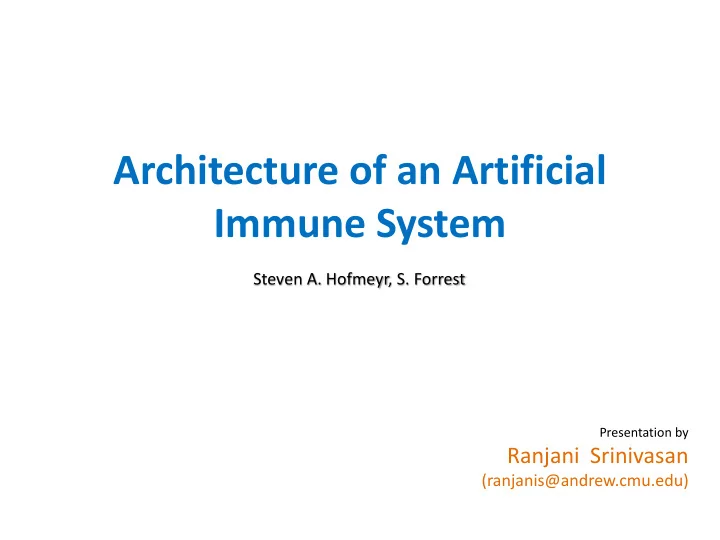

Architecture of an Artificial Immune System Steven A. Hofmeyr, S. Forrest Presentation by Ranjani Srinivasan (ranjanis@andrew.cmu.edu)
The Fellowship of the Immune System- The Defenders of the Realm
The Fellowship of the Immune System- The Defenders of the Realm Courtesy: Kurzgesagt – In a Nutshell, YouTube Channel. The Immune System explained
Properties of the Immune System (IS) Diverse, Distributed, Error Tolerant, Dynamic and Self-monitoring Robustness Adaptable – Recognize and respond to new infections, retain memory Autonomous – No outside control, difficult to impose outside control or inside centralized control. (Exceptions exist)
Basic Components of Immune Response Localized Interactions – chemical bonding Dynamic system of circulation Decentralized; no hierarchical organization Self-from-Nonself Improve to Harmful Nonself-from- EverythingElse Two sub-problems o Detection o Elimination
ARTificial Immune System ARTIS – Incorporates (most) properties of IS Independent of problem domain Situating in a domain can reduce unnecessary features or tailor features to problem
Problem definition Protein Chains – binary strings length l. Disjoint (assumption) subsets of Universe U, S and N Discrimination or Classification Task Errors – False Positives and False Negatives
Detectors Modeled after one class – Lymphocytes Combines properties of B-cells, T-cells, and antibodies Distributed environment modeled as graph G = (V,E) Affinity to epitopes (region on pathogen) – approximate string matching r-contiguous bits (More biologically consistent)
Detectors Activation of lymphocyte – when binding receptors exceeds threshold Modeling Activation Threshold – Match atleast τ strings in given time. Decay match count ( ϒ ). Once activated, reset count to zero.
Training the Detection System Negative Selection Algorithm Tolerization – in Thymus. Training set of self Assumption: Self occurs frequently compared to non-self ARTIS – Distributed Tolerization
Negative Selection Algorithm
Memory Rapid and efficient secondary response Associative Activated lymphocytes clone; Retain memory cells Multiple detectors at node in competition. Closest match – winner. Spread to neighboring nodes Memory detectors have lower activation thresholds => rapid response
Sensitivity Cytokines (chemicals) – signal to nearby IS cells Detection node , local sensitivity , Threshold of detectors at is ( τ - ) Matches at i go up, sensitivity is increased by 1 Temporal horizon with decay rate ϒ w
Co-stimulation T-cells require second signal of “damage” Model crude approximation of co- stimulation: human operator Co-stimulation delay T
Lifecycle of Detector Lympocytes short-lived. Dynamic population Model: p death for mature detectors Exception: Memory Detectors. Die only if no co-stimulation Problem? Limit fraction of memory detectors m d LRU (least Recently used) => Least useful (Is this a valid assumption?)
Lifecycle of Detector
Representation Population level diversity – MHC. Holes – occur if every match has a self counterpart; No valid detectors can be generated
Representation Each node with different representation. Modify all incoming detectors
Response Effector selection – many kinds B-cells – antibodies; Variable and constant regions Isotype Switching Implementation: Augment detector with effector choice
Summary What makes a system suitable for ARTIS? Pattern classification and Response Distributed architecture, scalable to arbitrary number of nodes Require detection of novel anomalous patterns Dynamic but normal behavior changes slowly Robust solution with no central control
Criticism Activation Threshold reduces false positive. But introduces paths of attack - Infrequent anomalous connections - Attack has fewer connections than threshold Assumption of infrequently occurring non-self LRU model assumption
Recommend
More recommend